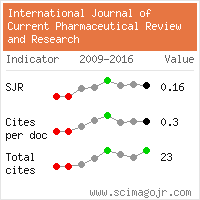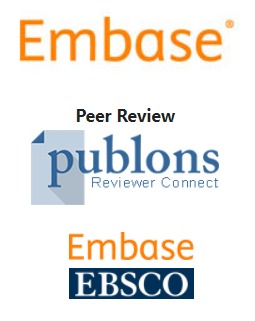1.
Lipid Nanoparticles: Future of Oral Drug Delivery and their Current Trends and Regulatory Issues
Kriti Soni, Bhavleen Kaur Kukereja, Manavi Kapur, Kanchan Kohli
Abstract
Lipid based nanoparticles have proved to be a boon to pharma research. It has offered a wide scope to fabricate drug delivery systems for hydrophilic as well as hydrophobic drug candidates with the advantage of being biocompatible, safe and nontoxic dosage forms with better drug loading and easy characterization parameters. Their scaling up being an easy task, has encouraged their industrial application. The article beautifully summarizes the different types of lipid nanoparticles, their methods of preparation, methods of characterization, regulatory aspects governing these nanoparticles, current trends and some developed lipid nanoparticles have also been listed so as to provide readers a deep insight into the vast scope of lipid based nanoparticles and their advantages.
Abstract Online: 11-November-2015
2. Total Phenol Content and Antioxidant Activity of
Bryum billardieri Schwaegr.
Magtoto L M, Alonzo E A M, Lacerna M Z T, Santiago J C
Abstract
Mosses contain active constituents that exhibit various biological activities. This study provides additional information on the potentials of mosses as natural sources of biologically active compounds that can be used as medicines. The antioxidant potential of
Bryum billardieri Schwaegr. (Bryaceae) is herein studied by analyzing its total phenol content and its radical scavenging activity. Ethanolic extract of
B. billardieri was prepared for Folin–Ciocalteau assay and 2,2’-Diphenyl-1-picrylhydrazyl radical scavenging assay. The total phenol content of
B. billardieri ethanolic extract was 38.18 gallic acid equivalence, while the mean percentage antioxidant activity was 93.024% ± 0.023, while its EC
50 was 0.0621%., signifying its potential as an antioxidant.
Abstract Online: 29-November-2015
3.
Exploration for Antimicrobial susceptibility of Proteins from Edible Marine Source Himantura gerrardi
Selvamani P, Latha S, Sherlina Daphny C, Arputha Bibiana M
Abstract
Marine organisms represent a valuable source of new compounds. The biodiversity of the marine environment and the associated chemical diversity constitute a practically unlimited resource of new active substances in the field of the development of bioactive products. Protein rich consumable marine fish named Stingray fish (Thirukkai meen) was collected from the seashore of Kanyakumari. Tissue and skin extracts were separated with the intention to identify antimicrobial proteins for the study. Tissue and skin were extracted by acetic acid, and it was partially purified using Ammonium sulphate precipitation method. Antimicrobial activity was done, and a maximum zone of inhibition was observed in
Staphylococcus aureus with tissue extract and a maximum zone of inhibition was found in
Klebsiella pneumoniae with skin extract by agar well diffusion method. The crude protein was quantified with 2 mg/ml for tissue extract and 1.26 mg/ml for skin extract. The FTIR analysis also revealed the presence of secondary amines in the crude extracts of tissue and skin. Time kill kinetics showed the results that the live bacterial cells were killed at the minimal concentration of the drug. Tissue extract showed a molecular weight ranging from 150 K.Da to10 K.Da and skin extract ranges below 25 K.Da by SDS-PAGE analysis. Agar overlay assay made possible to estimate the amount of antimicrobial activities of the proteins in a semi-quantitative manner and to identify such significant antibacterial activities in tissue extract. The molecular weight of tissue fraction from the obtained mass spectrum was about (app 10 K.Da), as determined by MALDI-TOF MS analysis. The antimicrobial proteins/peptides identified from these edible sources were found to be promising antibiotics that may replace the existing synthetic antibiotics with side effects.
Abstract Online: 19-December-2015
4.
Concurrent Infection of Typhoid and Dengue: A Vice Versa Study at Lakhimpur
Malakar Mridul, Choudhury Manjit, Thinsin Sibarani
Abstract
Dengue and Typhoid are two different diseases represents with fever, is one of the common symptoms. Our study was performed to determine concurrent infection of more than one disease as the diseases having some common symptoms. We have collected the blood samples from the suspected typhoid and dengue patients. The serum were separated from the blood samples and tested for typhoid and dengue by Typhidot, Widal test (tube and slide methods), dengue NS1 ELISA and dengue IgM ELISA. The test results showed that 3.40% numbers of patients were infected by both typhoid and dengue. 5.81 % dengue suspected patients were found negative for dengue but positive for typhoid. Again, 0.18% numbers of typhoid suspected patients found negative for typhoid but positive for dengue. From the test results, we can conclude that similar symptomatic diseases should be confirmed by laboratory tests only. To control the diseases government must take initiative to prevent the routes of the infections.
Abstract Online: 22-December-2015
5. Antiviral Activity of Sulfated Polysaccharides Carrageenan from Some Marine Seaweeds
Hanaa H A Gomaa, Gihan A. Elshoubaky
Abstract
In this study, the antiviral effect of carrageenan sulfated polysaccharides extracted from red alga
Acanthophora specifira and brown alga
Hydroclathrus clathratus was investigated against Herpes simplex virus type 1 (HSV-1) and Rift valley fever virus (RVFV). These viruses are serious pathogens to human and animal. Carrageenan content was increased in
Acanthophora specifira more than
Hydroclathrus clathratus.
Carrageenan hot water extract from these algae has shown a considerable antiviral property. Initially, cytotoxicity examination was conducted for crude aqueous Carrageenan. The maximum nontoxic dose (MNTD) treated Vero cells did not show any morphological difference when compared with control. These extracts were tested by MTT [3-(4,5-dimethylthiazol-2-yl)-2,5-diphenlytetrezolium bromide] method, cytopathic effect reduction assay, and plaque reduction assay to assess their cytotoxicity and antiviral activity. The antiviral effect was further determined by flow cytometric analysis. The results revealed that most of these extracts inhibited the propagation of HSV-1 and RVFV standard strains with minimal cytotoxicity to the host cells. The inhibition of viral replication was observed by amplify P53 gene (HSV-1) and BCL-2 gene (RVFV) the log 10 reduction in virus titer was observed compared with viral control.
Abstract Online: 26-December-2015
6. Glory lily (
Gloriosa superba L.) – A Review
S Padmapriya, K Rajamani, V A Sathiyamurthy
Abstract
Gloriosa superba is an herbaceous or semi-woody climber with v- shaped tubers. The plant is highly valued for its medicinal properties, more importantly for the treatment of cancer related diseases, arthritis, gout, rheumatism and impotency, containing the alkaloids, colchicines and colchicosides. Colchicine also acts as an anti-mitotic agent by inhibiting mitotic cell division. Thiocolchicoside (TCC), is a semi-synthetic derivative of naturally occurring colchicoside with anti-inflammatory and analgesic effects. The fascinating bright coloured flowers and hercogamous nature favours for cross pollination. Development of genotypes with improved seed yield, alkaloid content and field resistance to major pests and diseases are of paramount importance for catering the needs of phytopharmaceutical industries. Being a climber, glory lily requires support in the form of trellies or standards. Rapid multiplication of microtubers produced from the seed material has reduced the pressure on the dependency on wild harvested tubers. The present review focuses on the botany, medicinal uses, cytogenetics, floral biology, breeding methods, cultivation, post harvest technology and phytochemistry of glory lily.
Abstract Online: 30-December-2015
7.
Dietary Phytochemicals as Epi-drugs: Role in Modulating the Epigenetic Mechanisms of Human Diseases
C D Jayasinghe, Avlk Udalamaththa, I B P S Imbulana, I Suetake
Abstract
Epigenetic therapy is emerging as a promising approach against numerous human diseases. Though, the epigenetic mechanisms are essential for normal cellular functions, the aberrant epigenetic mechanisms, such as promoter DNA methylation, histone modifications, and miRNA-mediated post-transcriptional alterations contributes to the life style related diseases. Unlike genetic modification, the epigenetic modifications are reversible and often identified in early stages of diseases. Thus, targeting aberrant epigenetic modification has gained considerable attention in diseases prevention especially in cancer therapy and diagnosis. The concept of “epi drugs” is at the forefront of drug discovery which some are either approved or under clinical trials. The global demand for safe, cost effective and readily available therapeutics has a renewed interest in plant based drug leads which allow chronic use. A wide spectrum of secondary metabolites extracted from fruits, vegetable, teas and medicinal plants are known to regulate the epigenetic mechanisms and exhibit low toxicity in chronic administration. The applicability of major phytochemical groups such as polyphenols, terpenoids, organosulfur and alkaloids as epi-drugs against cancer and other diseases are experimentally established. Hence, the present review summarizes therapeutic potential of common dietary phytochemicals and their influence on major epigenetic mechanisms associated with human diseases, mostly against cancer and emphasizes their potential application as epi-drugs.
Abstract Online: 31-December-2015

